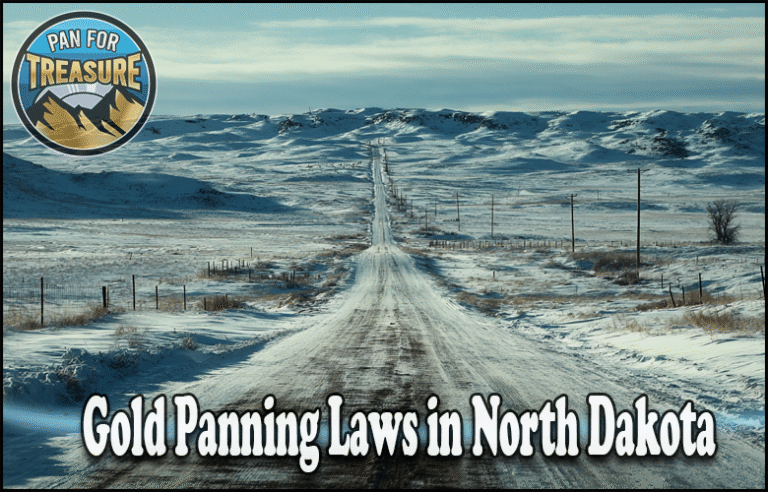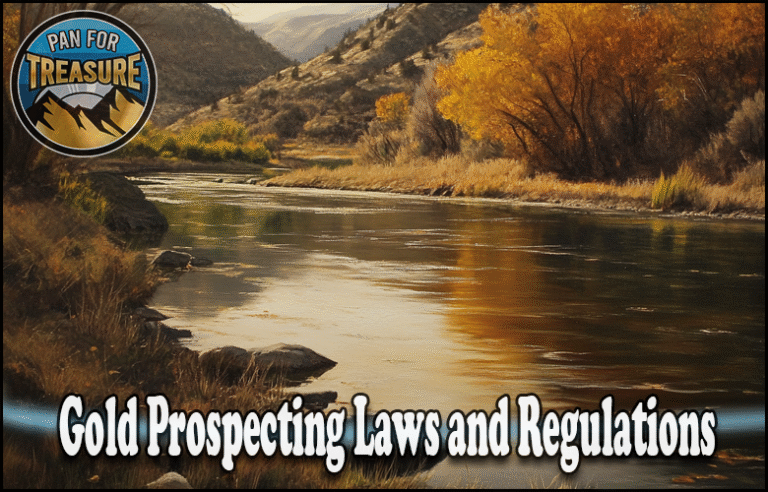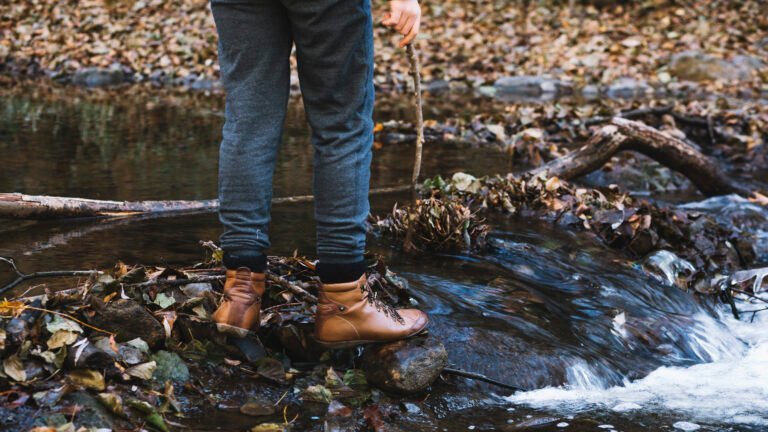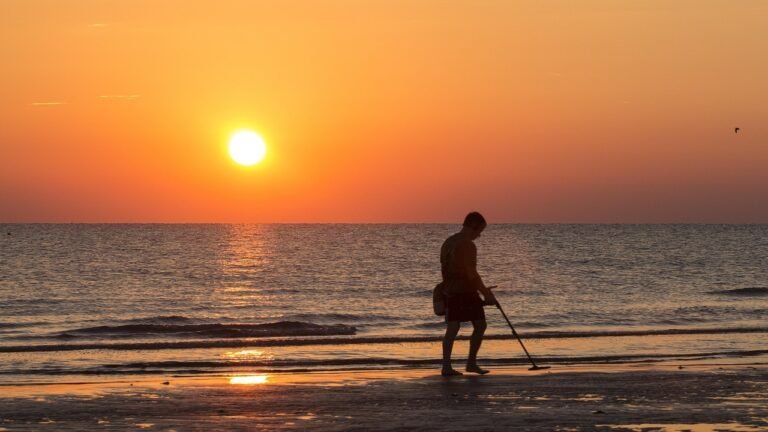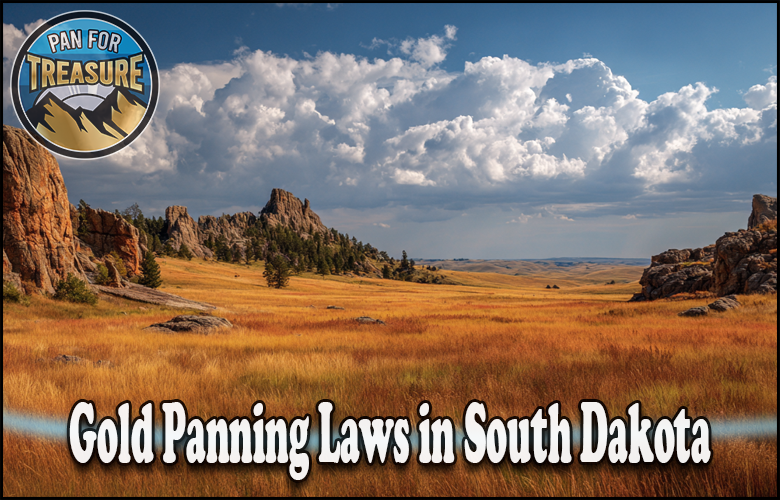
Disclosure: This Post Contains Affiliate Links; We earn a commission on purchases.
South Dakota has a long-standing tradition of gold mining, and gold panning remains a popular activity in the state to this day.
However, it’s essential for prospectors to understand the laws and regulations surrounding gold panning in South Dakota to ensure a legal and responsible experience.
Gold panning in South Dakota is subject to specific regulations that aim to protect both the environment and historical artifacts.
These regulations dictate where and how prospectors can engage in gold panning activities, and it’s important to adhere to them to avoid legal issues and minimize potential harm to the ecosystem.
Obtaining the necessary permits is crucial before embarking on a gold panning adventure in South Dakota. These permits grant prospectors the right to engage in recreational gold panning on public lands. Understanding South Dakota’s mining laws related to gold panning is also essential to ensure compliance and a successful gold panning experience.
There are various gold panning locations in South Dakota, including public lands such as the Black Hills National Forest. However, it’s crucial to respect private property rights and obtain permission before panning for gold on privately-owned lands. By doing so, prospectors can enjoy the opportunity to find gold while respecting the rights of landowners.
It’s important to note that there are restrictions on the types of equipment that can be used during gold panning in South Dakota. Mechanical tools such as dredges or motorized pumps are prohibited. Instead, prospectors are limited to using hand tools such as shovels, pans, sluice boxes, and metal detectors, ensuring a more environmentally-friendly approach to gold panning.
Key Takeaways:
- Gold panning in South Dakota is subject to specific laws and regulations.
- Permits are required to engage in recreational gold panning on public lands.
- Understanding South Dakota’s mining laws is crucial for a successful gold panning experience.
- Respect private property rights and obtain permission before gold panning on private lands.
- Mechanical tools are prohibited, and only hand tools are allowed for gold panning in South Dakota.
History of Gold Rush in South Dakota
South Dakota’s gold rush history dates back to 1874 when gold was discovered in the Black Hills region. This discovery sparked a frenzy, attracting fortune seekers from all over the country. The Black Hills Gold Rush, as it became known, led to the establishment of thriving gold rush towns in South Dakota, including Deadwood and Lead.
During the gold rush, these towns were bustling with activity as miners and prospectors flocked to the area in search of their fortunes. Famous figures such as Wild Bill Hickok and Calamity Jane became part of the legends and lore of the time, adding to the allure of the South Dakota gold rush.
While large-scale mining operations eventually took over many of the sites, individual prospecting is still allowed in designated areas today. The rich history of the gold rush in South Dakota continues to captivate locals and visitors alike, preserving the legacy of those who sought their fortunes in the Black Hills.
Exploring the gold rush towns and visiting historic sites not only provides a glimpse into the past but also highlights the significant role that gold mining played in shaping South Dakota’s history. Whether it’s walking the streets of Deadwood, visiting the Homestake Mine in Lead, or exploring the rich cultural heritage, the history of the gold rush in South Dakota is a fascinating chapter in the state’s story.
Related Gold Panning Information
Gold Panning Regulations in South Dakota
Gold panning in South Dakota is subject to specific regulations to ensure the safety of prospectors, protect natural resources, and preserve historical artifacts. Familiarizing yourself with these regulations is crucial before embarking on your gold panning adventure in the state.
Permitted Equipment
When gold panning in South Dakota, it is important to note that only hand tools are allowed. Mechanical equipment such as dredges or motorized pumps are prohibited. The following hand tools are permitted:
- Shovels
- Pans
- Sluice boxes
- Metal detectors
Land Use
Gold panning is allowed on public lands in South Dakota. However, it is crucial to respect private property rights and to obtain permission from landowners before entering private lands for gold panning activities. This ensures responsible and legal gold panning practices while minimizing any potential conflicts with landowners.
Environmental Considerations
During your gold panning expeditions, it is essential to prioritize environmental preservation. Do not dig or disturb sensitive areas, such as stream banks or wetlands, as they provide critical habitats for plants and animals. Additionally, avoid littering and properly dispose of any waste generated during the gold panning process to keep South Dakota’s natural landscapes pristine.
South Dakota Recreational Gold Panning Regulations
Recreational gold panners in South Dakota should be aware of the specific regulations that apply to their activities. While specific regulations may vary depending on the land management agency, general guidelines include:
- Obtaining the necessary permits or licenses for recreational gold panning.
- Adhering to seasonal restrictions, if any, to protect sensitive habitats or spawning grounds.
- Abiding by catch limits, if applicable, to promote sustainable gold panning practices.
- Reporting any significant discoveries or unusual findings, which may be of historical or scientific interest.
By following these regulations and guidelines, you can enjoy a legal and responsible gold panning experience in the beautiful state of South Dakota.
Public vs. Private Gold Panning in South Dakota
In South Dakota, gold panning enthusiasts have the option to choose between public and private gold panning experiences. Each option offers its own advantages and considerations.
Public Gold Panning in South Dakota
Public areas, such as the Black Hills National Forest and certain Bureau of Land Management (BLM) land, provide accessible locations for gold panning. These areas are open to anyone, allowing individuals to try their luck without any specific restrictions. Public gold panning spots offer a great opportunity to explore the natural beauty of South Dakota while prospecting for gold.
Private Gold Panning in South Dakota
Private companies in South Dakota provide guided gold panning tours and access to their own mining claims for a fee. Opting for a private gold panning experience can offer several benefits, including expert guidance, access to exclusive areas with a potentially higher concentration of gold, and the convenience of equipment and amenities provided by the company.
Private gold panning tours can be a worthwhile investment for individuals who want to maximize their chances of finding gold and gain insights from experienced prospectors. These tours often cater to both beginner and advanced prospectors, ensuring an enjoyable and educational experience for all.
Keep in mind that regardless of whether you choose to gold pan in a public area or participate in a private tour, it is essential to adhere to South Dakota’s gold panning laws and regulations. This includes obtaining the necessary permits and following guidelines to protect the environment and historical sites.
Table: Pros and Cons of Public and Private Gold Panning in South Dakota
| Public Gold Panning | Private Gold Panning |
|---|---|
| Open to anyone | Exclusive access to private mining claims |
| Fewer restrictions | Expert guidance from experienced prospectors |
| Exploration of public lands | Potentially higher chances of finding larger quantities of gold |
| Opportunity to connect with nature | Access to equipment and amenities provided by the company |
| Adherence to South Dakota gold panning laws and regulations is necessary | |
Best Time of Year for Gold Panning in South Dakota
When it comes to gold panning in South Dakota, timing can make all the difference. The best time of year to embark on your gold panning adventure is during the summer months when the weather is warm and dry. The favorable weather conditions create ideal conditions for prospecting and increase the chances of finding gold in the rivers and streams of South Dakota.
Spring can also be a great time for gold panning in South Dakota. As the snow melts away, it reveals new layers of sediment that may contain gold deposits. This period of transition from winter to summer provides an opportunity to explore fresh locations and uncover potential riches.
Fall can offer its own advantages for gold panning in South Dakota. With fewer crowds and less competition, you might have better luck finding gold deposits. The changing foliage and cooler temperatures create a serene and picturesque setting, adding to the overall experience.
However, it’s important to note that winters in South Dakota can be harsh, with heavy snowfall and freezing temperatures. These conditions can make it challenging to engage in gold panning activities. It’s advisable to wait for the warmer months when the weather improves and the snow has melted before heading out on your gold panning expedition.
| Season | Advantages | Disadvantages |
|---|---|---|
| Summer | Warm and dry weather | Increased competition |
| Spring | Melting snow reveals new sediment layers | Potential for cooler temperatures |
| Fall | Less crowded, better chances of finding gold | Changing weather conditions |
| Winter | No gold panning due to heavy snowfall and freezing temperatures | Unfavorable weather conditions |
Remember, the best time for gold panning in South Dakota ultimately depends on various factors such as weather conditions, personal preferences, and availability of time. Plan your trip accordingly and be sure to check the local weather forecast before heading out to maximize your chances of a successful gold panning experience.
Accommodation Options for Gold Panning Trip in South Dakota
Planning a gold panning trip to South Dakota? You’ll need a comfortable place to stay during your adventure. Luckily, there are various accommodation options available for gold prospectors in the state.
Camping
For those seeking an immersive outdoor experience, public campgrounds in South Dakota offer affordable and convenient access to gold panning locations. Set up your tent or park your RV amidst the natural beauty of the state’s campgrounds, and wake up to the sound of nature before heading out to search for gold.
Hotels and Motels
If you prefer a more comfortable lodging experience, there are plenty of hotels and motels near popular gold panning sites in South Dakota. These establishments provide amenities such as comfortable beds, private bathrooms, and easy access to nearby attractions. Choose from a range of accommodations to suit your budget and preferences.
Holiday Homes
For larger groups or families, holiday homes are a great option. Renting a vacation home near gold panning sites allows you to enjoy spacious living areas, multiple bedrooms, and fully equipped kitchens. This setup provides more flexibility and privacy, making it ideal for extended stays or group trips.
Historic Mining Towns
Immerse yourself in the rich history of gold mining by staying in historic mining towns like Deadwood and Keystone. These towns offer a unique blend of modern amenities and a glimpse into the past, providing an unforgettable experience. Explore the museums, casinos, and other attractions in these towns, and learn about the fascinating gold rush era.
Choose the accommodation option that best suits your preferences and budget, and make your gold panning trip to South Dakota truly memorable.
What to Bring and Pack for a Gold Panning Trip to South Dakota
When preparing for a gold panning trip to South Dakota, it is crucial to pack the essential gear and equipment to ensure a successful and enjoyable experience. Having the right tools will greatly enhance your chances of finding gold and make the entire adventure more rewarding.
Essential Equipment for Gold Panning
Here are some must-have items for your gold panning trip:
- Gold Pan: The most fundamental tool for gold panning, a sturdy gold pan helps you separate the sand and gravel from the gold particles.
- Shovel or Scoop: A durable shovel or scoop allows you to easily move larger amounts of material for more efficient panning.
- Classifier: A classifier or a sieve helps you filter out larger rocks and debris, allowing you to focus on smaller particles that may contain gold.
- Glass Vials: Small glass vials are perfect for safely storing any gold flakes or nuggets that you may discover.
Packing List for Gold Panning Trip
In addition to the essential equipment, it is important to pack appropriately for your gold panning adventure. Here is a packing list to ensure you are well-prepared:
- Appropriate Clothing: Wear durable pants, long-sleeved shirts, and sturdy footwear to protect yourself from scratches, insects, and the elements. Consider a hat or a cap for sun protection.
- Water Bottles: Stay hydrated throughout the day by bringing an adequate supply of water.
- Snacks: Pack energy bars or trail mixes to keep you fueled and energized during your gold panning activities.
- Sunscreen: Protect your skin from harmful UV rays by applying a high SPF sunscreen before heading out. Don’t forget to reapply as needed.
- Camera: Capture the memories of your gold panning trip with a camera or your smartphone to document your finds and the beautiful surroundings.
By packing the essential gear and following this packing list, you’ll be well-prepared for a successful and enjoyable gold panning experience in South Dakota.
| Essential Equipment for Gold Panning | Packing List for Gold Panning Trip |
|---|---|
|
|
Best Places for Gold Panning in South Dakota
South Dakota offers a wealth of prime locations for gold panning, attracting treasure hunters from near and far. These hotspots are known for their rich history, bountiful gold deposits, and beautiful natural settings.
The Black Hills region
The Black Hills region is a top destination for gold panning in South Dakota. Rapid Creek and Battle Creek, located within the Black Hills National Forest, are particularly popular among prospectors. This area is renowned for its abundant placer gold deposits, making it an excellent spot to try your hand at panning.
Deadwood
The historic town of Deadwood is not only famous for its Wild West past but also for its gold panning opportunities. Experience the thrill of prospecting where many fortune seekers once roamed. With its charming streets and gold-rich streams, Deadwood is an ideal place to uncover some treasures.
Hill City
Situated in the heart of the Black Hills, Hill City offers fantastic gold panning spots. Explore the creeks and rivers flowing through this picturesque town and try your luck at finding gold. The tranquil and scenic surroundings make Hill City a favorite destination for gold panners.
French Creek
French Creek is another well-known gold panning location in South Dakota. This waterway, flowing through the Black Hills, has produced significant amounts of gold throughout history. The beautiful landscapes and the promise of gold make French Creek an attractive destination for prospectors.
Whitewood Creek
Whitewood Creek, situated in Butte County, offers excellent opportunities for gold panning. This gold-bearing creek has witnessed significant mining activities in the past and continues to attract prospectors today. Prepare your tools and head to Whitewood Creek for a chance to strike it rich.
Spearfish Creek
Situated in Lawrence County, Spearfish Creek is a prime gold panning location in South Dakota. This scenic waterway is known for its gold-bearing deposits, making it a favorite among prospectors. Experience the thrill of gold panning in the picturesque surroundings of Spearfish Creek.
These are just a few of the best places for gold panning in South Dakota. Each location offers a unique experience and a chance to uncover gold nuggets or flakes. Remember to follow all laws and regulations, respect private property rights, and enjoy the adventure of gold panning responsibly.
Active, Old, and Abandoned Mines in South Dakota
South Dakota boasts a diverse array of gold mines, ranging from active operations to historic sites and abandoned remnants of the state’s rich mining history.
The Homestake Mine
One of the most renowned gold mines in South Dakota is the Homestake Mine, located in Lead. It was once the deepest gold mine in North America, reaching depths of over 8,000 feet. While the mine ceased operations in 2002, it has been repurposed as the Sanford Underground Research Facility, conducting groundbreaking scientific experiments.
Big Thunder Gold Mine
Situated in Keystone, the Big Thunder Gold Mine offers visitors a chance to experience the thrill of gold panning. This historic mine features guided tours that provide insights into the mining techniques of the past. Aspiring prospectors can try their luck at finding gold flakes in the mine’s designated panning areas.
Jewel Cave
Located in Custer, Jewel Cave is recognized as one of the longest caves in the world and serves as a popular tourist attraction. While not primarily a gold mine, it showcases the natural wonders of the underground environment where gold was once sought after.
Mystic Tin Mine
In Pennington County, the Mystic Tin Mine was once an active mine that produced both tin and gold. Today, it serves as a reminder of South Dakota’s mining legacy and contributes to the state’s cultural heritage.
Gilt Edge Mine
The Gilt Edge Mine, situated in Lawrence County, holds historical significance in South Dakota’s mining industry. It operated as an open-pit gold mine and played a vital role in the region’s economy. While the mine is no longer active, its impact on the local community remains a part of the state’s mining history.
These active, old, and abandoned mines showcase South Dakota’s rich mining heritage and offer unique opportunities for exploration, education, and appreciation of the state’s gold mining legacy.
| Mine | Location | Status |
|---|---|---|
| The Homestake Mine | Lead | Repurposed as a research facility |
| Big Thunder Gold Mine | Keystone | Tourist attraction |
| Jewel Cave | Custer | Tourist attraction |
| Mystic Tin Mine | Pennington County | Abandoned |
| Gilt Edge Mine | Lawrence County | Abandoned |
Conclusion
Gold panning in South Dakota offers a thrilling adventure for treasure hunters and outdoor enthusiasts. With its rich history, numerous gold panning locations, and legal opportunities, South Dakota is a prime destination for gold prospecting. By following the laws and regulations, obtaining necessary permits, and respecting the environment, prospectors can enjoy a rewarding and responsible gold panning experience in South Dakota.
Whether exploring the iconic Black Hills region, panning alongside picturesque rivers, or visiting historic mining towns, South Dakota provides a diverse range of options for gold panning enthusiasts. The state’s public lands and designated panning areas offer an ideal setting for beginners and experienced prospectors alike to uncover their own golden nuggets.
As you embark on your South Dakota gold panning adventure, remember to practice good stewardship of the land. Leave the environment as you found it, and be mindful of any artifacts or historical remnants you may encounter. Engage with local communities, discover the stories of the gold rush era, and immerse yourself in South Dakota’s mining heritage.
Source Links
- https://howtofindrocks.com/gold-prospecting-in-south-dakota/
- https://www.silverrecyclers.com/blog/panning-for-gold-in-south-dakota.aspx

Meet Ryan Conlon, the passionate owner and driving force behind Pan for Treasure.
With an unwavering love for the art of gold panning, Ryan has transformed his enthusiasm into a thriving community hub for fellow treasure seekers. info@panfortreasure.com
A seasoned gold panning enthusiast, Ryan’s journey began with a simple pan and a dream, evolving into a deep appreciation for the history, geology, and thrill of uncovering precious metals.
Subscribe to Our Newsletter

